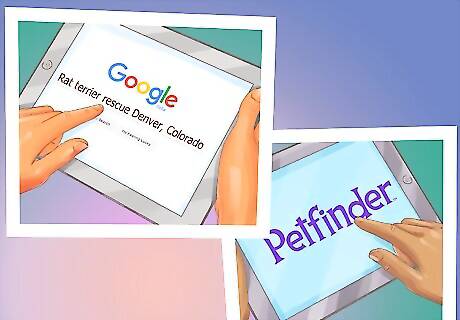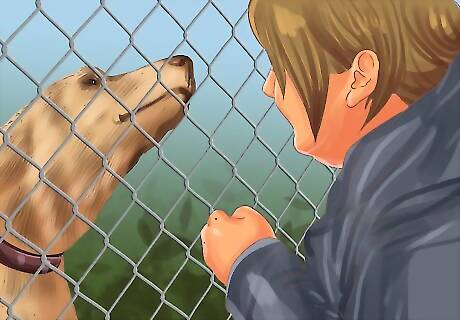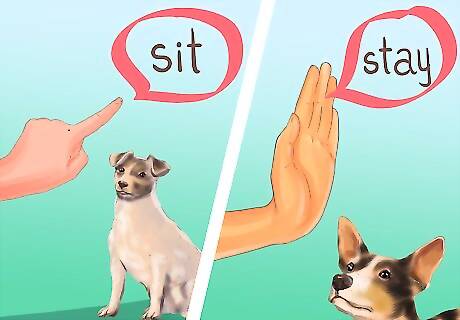
views
Finding a Terrier to Adopt

Call local animal shelters. Begin your journey toward adopting a terrier by contacting local animal shelters in your area. Do a quick internet search to locate the names, addresses, and numbers of animal shelters near you, then call or visit each one. When you call or visit, you might say, “I am interested in adopting a terrier. Do you currently have any terrier breeds available?”

Use an internet-based pet-finding service. Another great option is to use an online pet-finding service. Websites like Adopt a Pet, Animal Adoption Center, Best Friends Animal Society, or Petfinder allow you to search for specific breeds of dogs in your area. These websites can show you dogs from rescue organizations, shelters, and/or individuals. If you know a specific breed of terrier you are interested, it may be helpful to search for that breed. On Petfinder, for example, you can choose from 39 different terrier breeds (such as Welsh terrier, Boston terrier, and Australian terrier). You can also search for simply “terrier” and review all the (potentially hundreds of) results.

Seek out a terrier rescue organization. Often these groups are specific to one breed. Requirements will vary from organization to organization; however, rescue groups often have more rigorous applications and higher standards than typical shelters. Inquire about the application process and/or requirements before you start. You can look for animal rescue organizations in your area by conducting an internet search. Simply type “[breed of dog] rescue [name of your city]” into a search engine. For instance, you would type, “Rat terrier rescue Denver, Colorado.” Alternatively, you can use a service like Petfinder, looking specifically for dogs held by rescue groups. Your local vet may also know of dogs that need a home and be able to help you with arrangements.
Completing the Adoption Process

Be sure that you meet the requirements. Before you can adopt a terrier, you must be able to meet certain requirements. These can vary widely depending on the shelter/rescue organization you work with. However, some general requirements may include: Show valid identification. (You must be at least 18 years old.) Confirm that you have enough space. (Fortunately, most terriers are small.) Show proof of address. Spend at least 30 minutes with the dog you’d like to adopt. If you are a renter, check that pets are OK with your landlord and pay any additional fees or a deposit if it is required.

Complete adoption paperwork and pay a fee. Regardless of where you adopt your animal, there will be some sort of application process. You will need to complete some paperwork, and you will also need to pay a fee. The specifics of this process will vary from organization to organization. The fee amounts can vary depending on the medical services provided (such as vaccinations or sterilization). This fee can range from $50 to $300 and sometimes more. Often this fee includes necessary testing for diseases, medical treatments, spaying or neutering surgeries and required vaccinations.

Do a “home visit.” Some shelters and/or rescue groups will require you to take your terrier home for a trial run. This is known as a “home visit.” In some cases, this may just be for a few hours. In others, it could be overnight. Inquire about the possibility of a home visit when you begin the adoption process. Find out if any supplies (such as food) will be provided. Certain shelters will send a person to inspect your home before placing a dog in it, or will require a letter of reference from your veterinarian or others.
Taking Care of Your Terrier

Gather supplies. Before you bring your new terrier home, make sure you have all the supplies you need. This helps to create a smooth transition for your new dog, and allow them to feel comfortable and safe. Some things you will need include: A leash Food and water dishes Dog food A collar or harness A crate (optional) A dog bed Dog toys

Feed your dog. Fortunately, terriers do not generally require a special diet. Look for a blend of dog food formulated for small dogs and follow the serving guidelines based on your dog’s weight. You may want to consult your vet to select the best food for your dog. Ask the shelter what food they have been feeding the dog and see if you can get a week's supply from them. You can then mix the old food with the new food to reduce stomach problems that can happen when switching to a new food.

Train your terrier. Terriers are known for exuding “small dog syndrome” and can be quite stubborn. For this reason, terriers may take longer to housetrain than other dogs. This is why you must provide early and consistent training for your terrier. Establish yourself as the “pack leader” by setting boundaries for your dog. This can include things like staying off the furniture and not jumping when guests arrive. Additionally, you should teach your terrier basic commands (such as sit, stay, and lay down) and use them daily. It is highly recommended to seek some professional training while your terrier is young. Consider either a group obedience class or private lessons with a dog trainer to help train your terrier.

Provide daily exercise. Terriers have lots of energy to be burned, but a terrier needs you to be involved in their exercise. (They won’t be happy left alone in a yard.) Take your terrier on walks or jogs, bring them to a dog park, run with them on the beach, or play tug-of-war. A young terrier will need at least 30 minutes of vigorous activity, or one hour of moderate activity, per day. Always keep your dog on a leash unless they are in an enclosed yard or an off-leash dog park. Terriers are energetic dogs that can get away from you quickly if something grabs their attention.



















Comments
0 comment